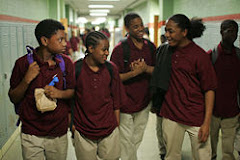I'm in the midst of teaching Persepolis with my 9th graders again, and I couldn't be happier. The books were a gift from The Children's Bookstore here in Baltimore; as part of their Educational Foundation program, which donates class sets of books to teachers and students (once a year per teacher), they granted our school around 350 copies of the text, one for every 9th grader. In other words, if you are looking for a great charity to support that directly puts books in the hands of Baltimore City students, then this is one I can vouch for. This is the second year in a row that they have supported me in the teaching of this book. A big public "thank you" to everyone involved over at The Children's Bookstore Educational Foundation!
Anyhow, as with last year, my students are really enjoying the book. Many came in the day after I had passed it out, proud of themselves for having went home and completed the entire book in one night. It's so neat to hear them analyze books using new terms, but fitting those terms into our standard "author's technique and effect" conversations about literature. I started off the unit by using much of this excellent lesson, which links to a fairly extensive list of graphic novels terms that we have been using. Never a comic book reader, I have learned a lot in the teaching of this novel, easily as much as my students have.
So far, we're only about five chapters into the story, but today we had an excellent little Socratic Seminar about chapter 3, and the students really did a good job of grappling with Satrapi's techniques and what effects they brought about. Tonight, students are choosing one panel in each of the next three chapters to write a paragraph of analysis about any three panels, using the vocabulary and technique/effect language. That will be a springboard for tomorrow's discussion.
********** Below is my proposal to The Children's Bookstore, which I think is pretty good but I can't quite believe I used the phrase "common humanity that links us all" twice in it... a bit cheesy************
January 29, 2008
The Children’s Bookstore Educational Foundation
737 Deepdene Rd.
Baltimore, MD 21210
To whom it may concern:
Last year, The Children’s Bookstore generously provided a copy of Marjane Satrapi’s Persepolis to each of my students. The experience was an enchanting one for my students and me. We learned about the culture of Iran, and about the troubling experience of coming of age in a society as repressive as that one. We learned about the structure of graphic novels, and analyzed how authors use pictures and words to tell a story. Most importantly, we learned about the common humanity that links us all, and saw how growing up in an unjust world has common threads across cultures. Students found the graphic novel style fresh and engaging, and the story captivating.
The unit was so successful that we are expanding it to all the ninth grade classes and, as chair of the ninth grade team, I am requesting Persepolis I for all ninth graders at ______________.
The following details the unit, goals, and projected activities and projects of the unit, which we are planning on teaching in April of 2008.
Teaching Unit: Coming of Age in the Middle-east: Examining the Graphic Novel
Curriculum Goals:
Throughout the course, students have examined coming-of-age stories from around the world, including the 1930s Alabama (To Kill a Mockingbird), 1500s Verona (Romeo and Juliet), 1950s Pittsburgh (Fences), 1980s Chicago (House on Mango Street), and ancient Greece (Telamachus' story in The Odyssey). Students have studied how injustice affects the growing up process, and how our response to injustice helps define how successful our coming of age is. This examination of these characters from different cultures, ethnicities, eras, genders, and perspectives will help students develop empathy and navigate their own coming of age in an unjust society. Persepolis details this same theme, in war-torn Iran in the early 1980s. We will use the text as a springboard for cultural connections, in order to examine the common humanity that unites us all.
Currently available texts and resources: None. Students are required to provide all of their own materials for English class.
Related activities and projects:
The study of the graphic novel as a relevant literary genre, including guest speaker experts in the genre
* Researching history and politics of middle-east and how it affects the people living within the area
* Examine universal themes and connections between cultures
* As a way of exploring effects of genre: Re-writing a section of a previously-studied novel as a graphic novel; writing portion of Satrapi’s graphic novel as prose
* Presentation on setting of Iran, including guest speakers from the country
Thank you so much for considering my proposal.
Resep Masakan
11 years ago

1 comment:
I can vouch for their interest in the book. Several times over the last few days I found myself saying, " that's a great story, but you need to put it away now and prepare for Monday's HSAs."
-The Chaplain
Post a Comment